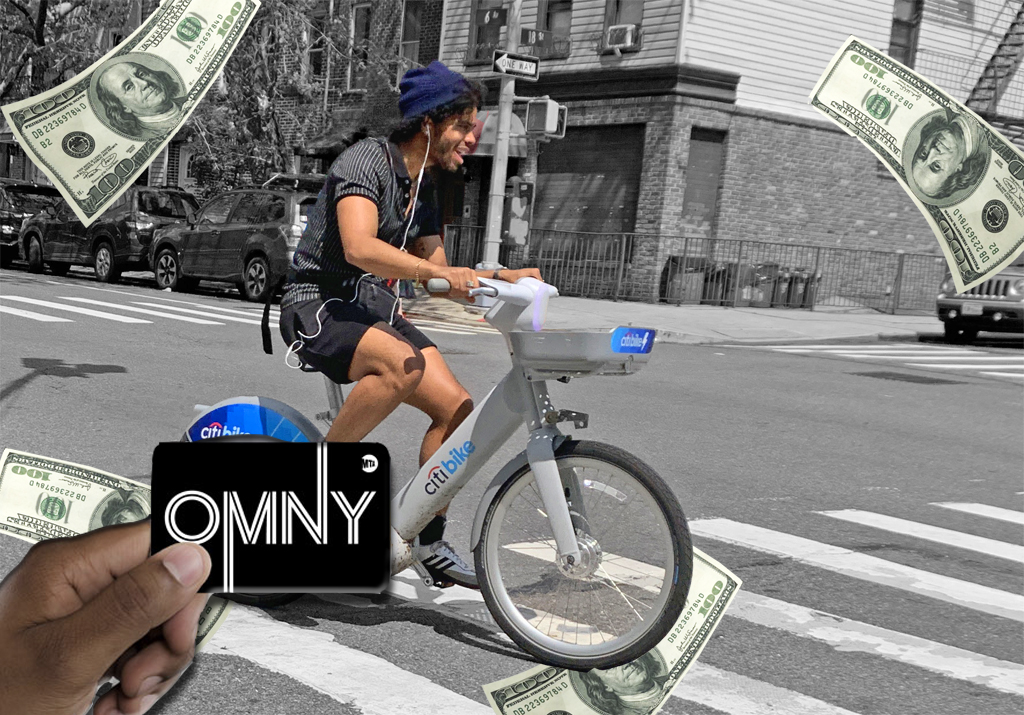It’s a fare idea!
Citi Bike could become even more popular if the MTA figured out a way to integrate OMNY, the new contactless fare system, with the Lyft-operated bike-share network, according to a Manhattan politician.
OMNY-Citi Bike integration “would remove another barrier to entry that would-be Citi Bikers face,” state Senator Brad Hoylman-Sigal (D-Midtown West) said in a letter this week to Lyft and MTA leadership.
“We urge you to create a unified payment system as expeditiously as possible,” he wrote.
OMNY compatibility could also address the scourge of vandalism of Citi Bike QR codes and identification numbers, which make the devices nearly impossible to rent.
“While more must be done to prevent and correct this type of vandalism, we also have to provide alternative means of payment to facilitate bike rentals,” Hoylman-Sigal said.
Bike-share systems in cities from Paris to Pasadena have incorporated local transit passes, including in cities where Lyft operates the bike-share and the MTA’s OMNY contractor, Cubic, runs the contactless payment system.
However, none of Citi Bike’s tens of thousands of docks can currently support “open loop” contactless payment systems like OMNY, which allow for the use of official OMNY cards as well as contactless bank or credit cards, a Citi Bike source said.
In California, Lyft’s Bay Wheels program is able to be integrated into Cubic’s local transit fare network because they run on a “closed loop” system where riders can only pay by loading official cards with cash, according to the source. The Port Authority’s SmartLink card for PATH trains operates in the same manner.
Fare collection in New York is scattered across multiple agencies and levels of government. The MTA is in the process of integrating its commuter rails into OMNY, but riders must still use separate fare systems for bike-share, NYC Ferry, PATH, NJ Transit and Amtrak.
The idea to simplify the Big Apple’s balkanized fare collection system has gained momentum among advocates on social media in recent weeks.
Time to integrate Citibike and NYC Ferry with OMNY?
— Shabazz Stuart (@ShabazzStuart) June 1, 2021
At minimum there should be free transfers to subways/busses. That’s how you get people back on mass transit, with innovative programs that make the experience easier and more seamless.
The MTA in fall of 2021 started selling the OMNY card, which is a closed-loop card that also uses the Mastercard payment network, allowing riders without bank accounts to pay in the OMNY system.
Citi Bikes could technically accept a closed-loop payment system like Bay Wheels do in the Golden State, but open-loop systems like OMNY require newer software and hardware to keep banking information secure, which would mean costly retrofits to the network of 60,000 docks in New York City, which are set to expand to 80,000 by the end of 2024, according to a source familiar with the technology.
Citi Bike is currently almost entirely funded by Lyft, while the Department of Transportation’s role is limited to siting stations.Transit systems in Los Angeles and Austin, Texas directly incorporate bike share into their agencies, and have one pass across both modes.
The New York region’s transit agencies, meanwhile, are notoriously fractured and territorial. Transit officials struggled to bring OMNY to their own commuter rail systems — to say nothing of the PATH train, whose operator the Port Authority now wants to create its own fare system separate from OMNY, which ironically stands for “One Metro New York.”
Helsinki and Singapore have tried to unify their transportation systems under one app, an effort experts label Mobility as a Service, or MaaS. The initiatives aim to reduce any friction for riders switching between modes, but the streamlining hasn’t necessarily lead to increase ridership, according to one researcher.
“It’s a nice-to-have, but not necessarily a huge game changer based on what we’ve seen in other places,” said David Zipper, a visiting fellow at the Harvard Kennedy School's Taubman Center for State and Local Government.
Riders are generally okay with using different payment methods, Zipper said. The main driver of getting people out of cars is whether alternatives are widely available and affordable, he added — so officials would be better off investing in having more docks, especially close to transit.
In San Francisco I was able to use Clipper as a key card to unlock this exact model of bike. I wonder if @jordanlevine1 can ask their tech team to check if the OMNY card is compatible. pic.twitter.com/j1i3OpHzl3
— ✧ M'aya マヤ|海外ナイト ✧ (@rolanberrypie) June 4, 2023
Lyft spokesperson Jordan Levine said the company is “in touch with the MTA on the topic,” while MTA rep Eugene Resnick said authority officials are “reviewing opportunities for future expansion such as those called out in the Senator’s letter.”
Cubic spokesperson Bonnie Crawford said OMNY was "built as a platform allowing additional transit options including bike share to be incorporated over time."
"We are excited to hear of continued interest to deliver the benefits of OMNY to more New Yorkers and look forward to working with the MTA on expanding their vision of OMNY as a regional fare payment system utilized across many modes of travel," the rep added.






